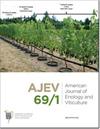Evaluation of a Laser-Guided Intelligent Sprayer for Disease and Insect Management on Grapes
IF 1.8
3区 农林科学
Q3 BIOTECHNOLOGY & APPLIED MICROBIOLOGY
引用次数: 0
Abstract
Background and goals New pesticide spray technologies are needed to replace inefficient conventional air-assisted practices for protecting grapes from diseases and insect pests. Methods and key findings A laser-guided intelligent sprayer was evaluated in an experimental vineyard for three consecutive growing seasons. Treatments included the intelligent sprayer with low (0.065 L/m 3 ) and high (0.13 L/ m 3 ) base spray deposition rates, and the conventional constant-rate application using the same sprayer but with the intelligent functions deactivated (935.4 L/ha). Evaluations included comparisons of spray coverage and deposition uniformity within vines, spray volume consumption, chemical cost savings, control of fungal diseases and Japanese beetles, and yields among the three treatments and nontreated plots as control. The conventional treatment consistently produced excessively higher spray coverage within vines than the low-and high-rate intelligent sprayer treatments, while spray deposition uniformity on grapevines did not differ significantly among treatments. Even though foliar disease severity was significantly higher in the intelligent low-rate treatment, marketable yields were not significantly different from either the intelligent high-rate or conventional constant-rate treatments; however, marketable yields in the intelligent low-rate treatment were 1.7 times higher than in nontreated plots. Japanese beetle incidence and herbivory varied significantly among treatments depending on sampling date, however, intelligent low-and high-rate treatments had significantly fewer beetles in the grapevine canopy than nontreated control plots for the majority of sampling periods each year. Furthermore, intelligent high-rate treatments suppressed Japanese beetles just as well as conventional air-assisted treatments. The intelligent spray treatments reduced spray volume by 29 to 83% compared to the conventional spray treatment, resulting in annual chemical savings of US$469 (high rate) and US$712 (low rate) per hectare. Conclusions and significance Intelligent sprayer technology could offer economically sustainable management of fungal and oomycete diseases and Japanese beetles for grape production.激光引导智能喷雾器在葡萄病虫管理中的应用研究
背景与目的需要新的农药喷雾技术来取代低效的传统空气辅助方法来保护葡萄免受病虫害的侵害。方法和主要发现采用激光引导智能喷雾器在一个实验葡萄园连续三个生长季节进行了评价。处理包括低(0.065 L/m 3)和高(0.13 L/m 3)基础喷雾沉积速率的智能喷雾器,以及使用相同喷雾器但关闭智能功能(935.4 L/ha)的常规恒定速率喷雾器。评价包括比较喷施覆盖率和葡萄藤内沉积均匀性、喷施量消耗、化学品成本节约、真菌病害和日本甲虫的防治以及三种处理和未处理地块的产量。与智能喷雾器低速率和高速率处理相比,常规处理在葡萄藤内的喷淋覆盖率一直过高,而不同处理在葡萄藤上的喷淋均匀性差异不显著。尽管低速率智能处理的叶面病害严重程度显著高于低速率智能处理,但可售产量与高速率智能处理或常规恒速率智能处理均无显著差异;然而,低速率智能处理的可销售产量是未处理地块的1.7倍。在不同的采样期,不同处理的葡萄冠层甲虫的发病率和食性差异显著,但在每年的大部分采样期,智能低率和高率处理的葡萄冠层甲虫数量明显少于未处理的对照。此外,智能的高倍率处理与传统的空气辅助处理一样抑制了日本甲虫。与传统喷雾处理相比,智能喷雾处理减少了29%至83%的喷雾量,每年每公顷可节省469美元(高费率)和712美元(低费率)的化学费用。结论与意义智能喷雾器技术可为葡萄生产提供经济可持续的真菌、卵霉菌病害和日本甲虫病害管理。
本文章由计算机程序翻译,如有差异,请以英文原文为准。
求助全文
约1分钟内获得全文
求助全文
来源期刊

American Journal of Enology and Viticulture
农林科学-生物工程与应用微生物
CiteScore
3.80
自引率
10.50%
发文量
27
审稿时长
12-24 weeks
期刊介绍:
The American Journal of Enology and Viticulture (AJEV), published quarterly, is an official journal of the American Society for Enology and Viticulture (ASEV) and is the premier journal in the English language dedicated to scientific research on winemaking and grapegrowing. AJEV publishes full-length research papers, literature reviews, research notes, and technical briefs on various aspects of enology and viticulture, including wine chemistry, sensory science, process engineering, wine quality assessments, microbiology, methods development, plant pathogenesis, diseases and pests of grape, rootstock and clonal evaluation, effect of field practices, and grape genetics and breeding. All papers are peer reviewed, and authorship of papers is not limited to members of ASEV. The science editor, along with the viticulture, enology, and associate editors, are drawn from academic and research institutions worldwide and guide the content of the Journal.
 求助内容:
求助内容: 应助结果提醒方式:
应助结果提醒方式:


